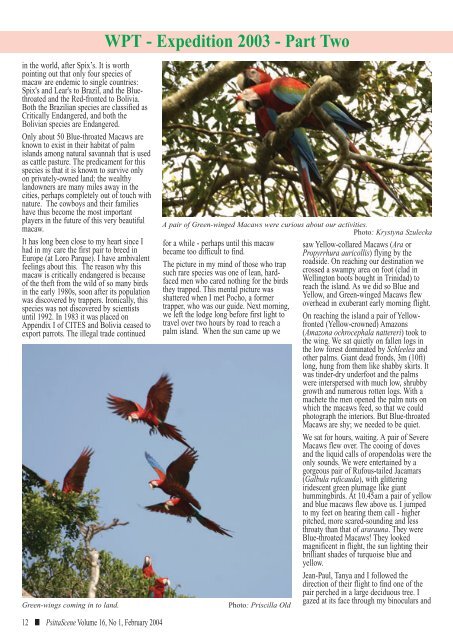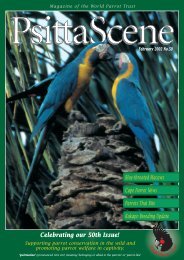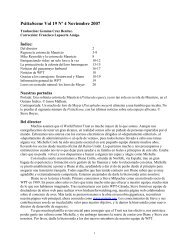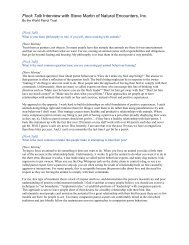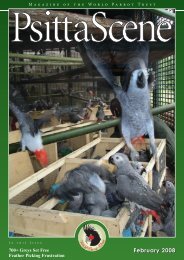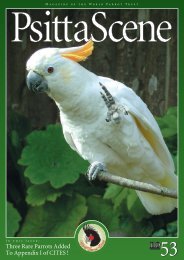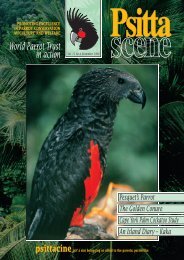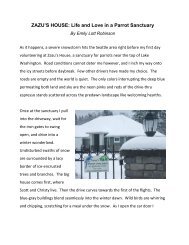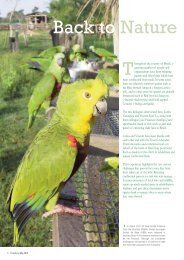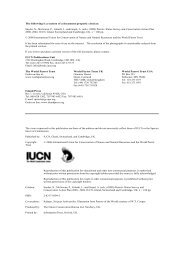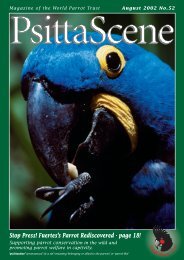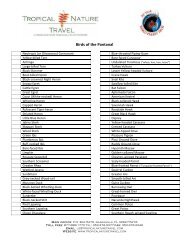February 2004 - World Parrot Trust
February 2004 - World Parrot Trust
February 2004 - World Parrot Trust
Create successful ePaper yourself
Turn your PDF publications into a flip-book with our unique Google optimized e-Paper software.
WPT - Expedition 2003 - Part Two<br />
in the world, after Spix’s. It is worth<br />
pointing out that only four species of<br />
macaw are endemic to single countries:<br />
Spix's and Lear's to Brazil, and the Bluethroated<br />
and the Red-fronted to Bolivia.<br />
Both the Brazilian species are classified as<br />
Critically Endangered, and both the<br />
Bolivian species are Endangered.<br />
Only about 50 Blue-throated Macaws are<br />
known to exist in their habitat of palm<br />
islands among natural savannah that is used<br />
as cattle pasture. The predicament for this<br />
species is that it is known to survive only<br />
on privately-owned land; the wealthy<br />
landowners are many miles away in the<br />
cities, perhaps completely out of touch with<br />
nature. The cowboys and their families<br />
have thus become the most important<br />
players in the future of this very beautiful<br />
macaw.<br />
It has long been close to my heart since I<br />
had in my care the first pair to breed in<br />
Europe (at Loro Parque). I have ambivalent<br />
feelings about this. The reason why this<br />
macaw is critically endangered is because<br />
of the theft from the wild of so many birds<br />
in the early 1980s, soon after its population<br />
was discovered by trappers. Ironically, this<br />
species was not discovered by scientists<br />
until 1992. In 1983 it was placed on<br />
Appendix I of CITES and Bolivia ceased to<br />
export parrots. The illegal trade continued<br />
Green-wings coming in to land.<br />
A pair of Green-winged Macaws were curious about our activities.<br />
Photo: Krystyna Szulecka<br />
for a while - perhaps until this macaw<br />
became too difficult to find.<br />
The picture in my mind of those who trap<br />
such rare species was one of lean, hardfaced<br />
men who cared nothing for the birds<br />
they trapped. This mental picture was<br />
shattered when I met Pocho, a former<br />
trapper, who was our guide. Next morning,<br />
we left the lodge long before first light to<br />
travel over two hours by road to reach a<br />
palm island. When the sun came up we<br />
Photo: Priscilla Old<br />
saw Yellow-collared Macaws (Ara or<br />
Propyrrhura auricollis) flying by the<br />
roadside. On reaching our destination we<br />
crossed a swampy area on foot (clad in<br />
Wellington boots bought in Trinidad) to<br />
reach the island. As we did so Blue and<br />
Yellow, and Green-winged Macaws flew<br />
overhead in exuberant early morning flight.<br />
On reaching the island a pair of Yellowfronted<br />
(Yellow-crowned) Amazons<br />
(Amazona ochrocephala nattereri) took to<br />
the wing. We sat quietly on fallen logs in<br />
the low forest dominated by Schleelea and<br />
other palms. Giant dead fronds, 3m (10ft)<br />
long, hung from them like shabby skirts. It<br />
was tinder-dry underfoot and the palms<br />
were interspersed with much low, shrubby<br />
growth and numerous rotten logs. With a<br />
machete the men opened the palm nuts on<br />
which the macaws feed, so that we could<br />
photograph the interiors. But Blue-throated<br />
Macaws are shy; we needed to be quiet.<br />
We sat for hours, waiting. A pair of Severe<br />
Macaws flew over. The cooing of doves<br />
and the liquid calls of oropendolas were the<br />
only sounds. We were entertained by a<br />
gorgeous pair of Rufous-tailed Jacamars<br />
(Galbula ruficauda), with glittering<br />
iridescent green plumage like giant<br />
hummingbirds. At 10.45am a pair of yellow<br />
and blue macaws flew above us. I jumped<br />
to my feet on hearing them call - higher<br />
pitched, more scared-sounding and less<br />
throaty than that of ararauna. They were<br />
Blue-throated Macaws! They looked<br />
magnificent in flight, the sun lighting their<br />
brilliant shades of turquoise blue and<br />
yellow.<br />
Jean-Paul, Tanya and I followed the<br />
direction of their flight to find one of the<br />
pair perched in a large deciduous tree. I<br />
gazed at its face through my binoculars and<br />
12 ■ PsittaScene Volume 16, No 1, <strong>February</strong> <strong>2004</strong>


